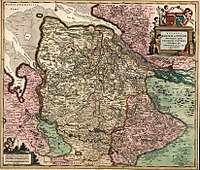County of Delmenhorst
|
Territory in the Holy Roman Empire |
|
|---|---|
| County of Delmenhorst | |
| coat of arms | |

|
|
| map | |

|
|
| Map of the area around Bremen from 1655 with the county of Delmenhorst
|
|
| Today's region / s | DE-NI |
| Parliament | Reichsfürstenbank / Niederrheinisch-Westfälisches Reichsgrafenkollegium : 1 vote from 1647 (via Oldenburg) |
| Reich register | 1663: 2 horsemen, 14 foot soldiers |
| Reichskreis | Lower Rhine-Westphalian (via Oldenburg) |
| Capitals / residences | Delmenhorst |
| Dynasties | House Oldenburg |
| Denomination / Religions | Lutheran |
| Language / n |
German , Low German
|
| Incorporated into |
Duchy of Oldenburg
|
The county of Delmenhorst was a territory in the Holy Roman Empire . It had its focus around the city of Delmenhorst .
history
Origin of the rule was that of the Count of Oldenburg , I. Otto and his nephew John I , built castle Delmenhorst . This was first mentioned in writing in 1254. From the end of the 13th century it was the seat of a branch line of the Counts of Oldenburg. A separate county was established around Delmenhorst. An older line of the Counts Oldenburg-Delmenhorst existed from 1281 to 1447. One of the counts from this line, Otto IV. , Had pledged the county in 1414 to the Archbishopric of Bremen . The last count of this line was Nikolaus von Oldenburg-Delmenhorst . On December 20, 1420, he transferred the castle and rule of Delmenhorst to the Archbishopric of Bremen, then received them back as a fief and was elected archbishop by the Bremen cathedral chapter in 1421 . He was captured after the Battle of Detern in 1426 and had to resign as archbishop in 1436. After his death, Delmenhorst was united with Oldenburg.
A middle line established by Count Moritz III. von Oldenburg only existed from 1463 to 1464. After Moritz's death, his inheritance was still underage. Thereupon Count Gerd von Oldenburg -Delmenhorst took possession again for Oldenburg.
Bishop Heinrich von Münster had his rights to Delmenhorst confirmed in 1476 and had the area conquered in 1482. The road robberies of the Oldenburg counts also played a role. In the feud of Münster-Oldenburg in 1538, the bishopric Münster was able to hold Delmenhorst. In the course of the Schmalkaldic War , however, it lost the area to Count Anton I of Oldenburg in 1547 .
After Anton I's death, his eldest son Johann XVI took over . of Oldenburg the reign of the counties of Oldenburg and Delmenhorst. On November 3, 1577, his younger brother Anton II gained control of the county of Delmenhorst and other possessions by means of a partition agreement. 1597 confirmed imperial Reichshofrat the complete elimination of the County of Oldenburg. With this, Anton II became the founder of a younger line Oldenburg-Delmenhorst in 1577. After the death of his son Christian IX. In 1647 Delmenhorst finally fell back to Oldenburg. Through this she was represented in the Lower Rhine-Westphalian Reichsgrafenkollegium . The area was about 12 square miles. With Oldenburg it came to Denmark in 1667 . Administratively, the territory was administered by the German Chancellery in Copenhagen . From 1711 to 1731 the county was pledged to the Electorate of Hanover . In 1774, after the Treaty of Tsarskoe Selo, the Danish royal family exchanged the counties of Oldenburg and Delmenhorst for the ducal shares of Holstein in the older Holstein-Gottorf line , which the counties in turn ceded to the younger line of the house. In addition, Emperor Joseph II combined Oldenburg and Delmenhorst to form the Duchy of Oldenburg , which finally ended the independence of the County of Delmenhorst. The new sovereign was consequently the Prince-Bishop of Lübeck Friedrich August von Holstein-Gottorp as Duke of Oldenburg from the younger line of the House of Schleswig-Holstein-Gottorf.
At the end of 1810, the duchy was annexed by the French Empire and added to the newly founded department of the mouths of the Weser . After 1815 and the end of the French occupation , Delmenhorst became part of Oldenburg again.
See also
literature
- Gerhard Köbler : Historical lexicon of the German countries. The German territories from the Middle Ages to the present . 7th completely revised edition. Beck, Munich 2007, ISBN 978-3-406-54986-1 , p. 132 ( limited preview in the Google book search).
- Alfred Bruns: County of Delmenhorst . In: Gerhard Taddey (Hrsg.): Lexicon of German history . 2. revised Ed., Stuttgart 1982, ISBN 3-520-80002-0 , p. 242.
Web links
Individual evidence
- ^ Dieter Rüdebusch: Nikolaus, Graf von Oldenburg-Delmenhorst In: Hans Friedl u. a. (Ed.): Biographical manual for the history of the state of Oldenburg . Edited on behalf of the Oldenburg landscape. Isensee, Oldenburg 1992, ISBN 3-89442-135-5 , pp. 522-523 ( online ).